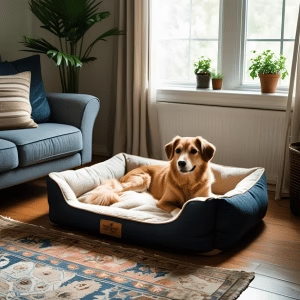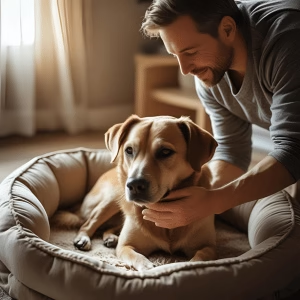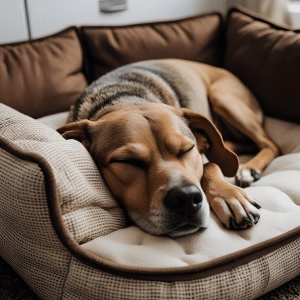So, you’ve just brought home a furry friend from the shelter, congratulations! But if you’re dealing with restless nights, anxious whining, or a pup who thinks 3 AM is party time, you’re definitely not alone.
Here’s the thing about creating the perfect bedtime routine for your dog, it’s not just about getting better sleep (though that’s a nice bonus). It’s about helping your new companion feel secure, loved, and truly at home.
Think about it this way: your rescue dog has likely been through some serious changes, maybe even trauma. A consistent, calming bedtime routine becomes their anchor, a signal that says, “Hey, you’re safe now. You can finally relax.”
And guess what? When your dog sleeps well, you sleep well too. Win-win!
But here’s the deal, establishing a solid dog bedtime routine doesn’t happen overnight. Pun intended. With patience, consistency, and the right approach though, you’ll both be enjoying peaceful nights sooner than you think.
Why Your Rescue Dog Actually Needs This
Dogs are creatures of habit. Period.
And this is especially true for shelter dogs who’ve experienced uncertainty. A structured routine helps reduce anxiety and creates predictability in their new world. When your pup knows what to expect each evening, they can start to relax instead of staying on high alert for the next change.
Research shows that dogs with consistent routines experience lower stress levels and better overall well-being. For newly adopted dogs? This structure becomes even more crucial as they navigate their new environment and bond with their family.
Pretty important stuff, right?
Many rescue dogs come from challenging backgrounds and may have special needs that require extra attention, if you’re considering adopting a pet with special needs, it’s important to understand the unique care requirements involved.
Step 1: Nail the Timing
Start your wind-down routine 30-60 minutes before actual bedtime. This gives your dog time to transition from “let’s play fetch forever” mode to “time for sleepy dreams” mode.
Most dogs need about 12-14 hours of sleep per day, so factor this into your schedule. For adult dogs, bedtime typically falls between 9-11 PM, but adjust based on your household schedule.
The key? Consistency. Choose a time you can stick with long-term, even on weekends when you’d rather binge-watch Netflix until 2 AM.
Step 2: Create Their Perfect Sleep Sanctuary
Your dog’s sleeping area should be their personal sanctuary. Choose a quiet, low-traffic spot where they won’t be disturbed by household chaos. Whether it’s a cozy dog bed, crate, or designated corner, make it comfortable and inviting.
Environmental considerations that actually matter:
- Dim the lights gradually as bedtime approaches to trigger natural melatonin production
- Keep the temperature comfortable (around 65-70°F)
- Consider using a crate cover for dogs who prefer darker spaces
- Remove stimulating toys that might encourage midnight zoomies
Think of it as creating a five-star hotel experience, but for your dog.
We dig this topic deeper in our How to prepare your home for a rescue dog article
Step 3: Wind Down with the Right Activities
About 30 minutes before bedtime, shift into calm mode. This means no vigorous play, exciting games, or anything that gets their tail wagging like crazy.
Instead, focus on gentle, bonding experiences:
What actually works for wind-down time:
- Gentle evening walk – a leisurely stroll, not an energetic marathon
- Quiet cuddle time on the couch for 10-20 minutes
- Light brushing or massage to help them relax
- Calm training sessions with simple commands and treats
Avoid bath time or anything that might get your dog excited or anxious during this period. Save the bubble baths for daytime!
Step 4: The Non-Negotiable Potty Break
This step is absolutely non-negotiable. Take your dog outside for one final bathroom break right before settling them for the night. Give them plenty of time to relieve themselves completely, rushing this step often leads to those dreaded 3 AM wake-up calls.
For puppies under 6 months? Remember they can only hold their bladder for a few hours, so you might need additional nighttime breaks. It’s just part of the puppy package deal.
Step 5: Master the Sleep Signals
Dogs learn through repetition and association. Create clear signals that bedtime has officially arrived:
- Use a consistent phrase like “bedtime” or “go to bed”
- Turn off main lights and switch to dim lighting
- Guide them to their sleeping area with gentle encouragement
- Offer a small, healthy bedtime treat to create positive associations
- Put on calming music or white noise if it helps
Think of it as creating a bedtime ritual that even humans would envy.
Step 6: The Settling Process That Works
Once your dog is in their designated sleep area, spend a few minutes helping them settle. This might include:
- Gentle petting until they lie down
- Soft, reassuring words in a calm voice
- Staying nearby for a few minutes if they’re anxious
- Leaving a comfort item with your scent nearby
For anxious dogs, consider using calming scents like lavender or comfort toys that provide security. Sometimes the smallest touches make the biggest difference.
Step 7: The Make-or-Break Factor – Consistency
Here’s where many dog owners struggle, and honestly, it’s the most important part. Consistency is absolutely crucial. Dogs thrive on routine, and breaking it confuses them and can undo all your hard work.
This means:
- Following the same sequence every single night
- Sticking to the same bedtime, even on weekends
- Having all family members follow the same routine
- Being patient during the adjustment period (typically 2-4 weeks)
No shortcuts here, folks.
When Things Don’t Go According to Plan
My dog gets the “zoomies” at bedtime: This often indicates they haven’t had enough physical or mental exercise during the day. Increase daytime activity and ensure they’re truly tired by bedtime.
They whine or bark when left alone: This is super common with newly adopted dogs experiencing separation anxiety. Try leaving a piece of your clothing nearby, or consider letting them sleep closer to you initially before gradually moving them to their designated spot.
They keep getting up during the night: Check for medical issues first, then evaluate their evening routine. Are they drinking too much water before bed? Did they have enough exercise? Sometimes a small adjustment makes all the difference.
Special Notes for Your Shelter Superstar
Newly adopted dogs often come with unique challenges. They might have anxiety, unfamiliar triggers, or simply need time to adjust to their new environment. Be extra patient and consider these tips:
- Start slowly, don’t expect perfect behavior immediately
- Watch for signs of stress like panting, pacing, or destructive behavior
- Consult your veterinarian if sleep issues persist beyond a few weeks
- Consider calming aids like anxiety wraps or pheromone diffusers if recommended by your vet
Remember, they’re still figuring out that this is their forever home.
The Long Game
The perfect bedtime routine for your dog is one that works for both of you. Some dogs adapt quickly, while others need weeks to fully settle into their new routine. The investment in time and consistency pays off with years of peaceful nights and a stronger bond with your furry friend.
Your rescue dog has already been through so much change. By providing them with a predictable, calming bedtime routine, you’re giving them the gift of security and helping them understand that they’re finally, truly home.
And honestly? That’s pretty amazing.
Quick-Fire FAQ Action
Q: How long does it take for a dog to adjust to a new bedtime routine?
A: Most dogs adapt to a new routine within 2-4 weeks with consistent implementation. Newly adopted dogs might take a bit longer as they’re adjusting to many changes simultaneously.
Q: Should I let my rescue dog sleep in my bed?
A: While it’s tempting, it’s generally better to establish their own sleeping space first. Once they’re comfortable and well-adjusted, you can decide if bed-sharing works for your household.
Q: What if my dog seems anxious during the bedtime routine?
A: Go slower and make the routine even more calming. Consider using comfort items, calming scents, or consulting with your veterinarian about anxiety management techniques.
Q: Is it normal for my newly adopted dog to have accidents at night?
A: Yes, especially in the first few weeks. Stress, new environment, and schedule changes can affect bathroom habits. Maintain consistent potty breaks and be patient.
Q: Can I use calming supplements to help with bedtime?
A: Always consult your veterinarian before giving any supplements. They can recommend safe, effective options if needed for your specific dog’s situation.
Resources
American Kennel Club – Dog Sleep Patterns Guide
ASPCA – Dog Anxiety Resources






